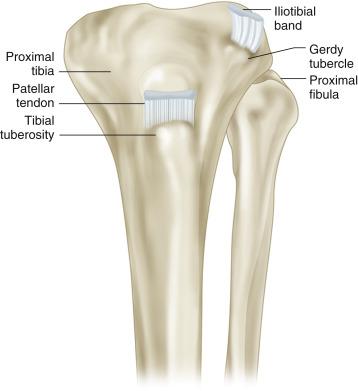Physical Address
304 North Cardinal St.
Dorchester Center, MA 02124
Fusions and complex fractures in the foot and ankle often require cancellous bone graft.
Ample bone (≤30 cc) is available from the proximal tibia.
Bone harvest from the proximal tibial is less painful then from the iliac crest.
The tibial site can easily be draped into the operative field.
Iliac crest, distal tibia, or calcaneal autograft
Allograft
Bone graft substitutes
The tibial tubercle is a large, oblong elevation where the anterior surfaces of the condyles of the tibia meet and where the patella tendon attaches ( Fig. 77.1 ).

From medial to the tibial tubercle, the proximal tibia is subcutaneous.
The Gerdy tubercle is on the lateral aspect of the tibial tubercle, where the distal bands of the iliotibial band insert.
The anterior crest of the tibia starts at the tibial tubercle and ends at the anterior margin of the medial malleolus.
The anterior crest is sinuous and prominent in the proximal two thirds of the tibia, whereas it is rounded in the distal third.
The anterior crest provides attachment for the deep fascia.
Glenn B. Pfeffer
The leg can usually be rotated externally to access the proximal medial tibia.
Slight flexion of the hip and knee by blankets placed beneath the sterile field will facilitate rotation of the leg and exposure of the medial graft site.
If the patient is in a lateral decubitus position for the surgery, the graft can be harvested from the lateral aspect of the tibia (see Lateral Approach, below), or the patient placed more supine after the foot/ankle have been prepared for the fusion.
Become a Clinical Tree membership for Full access and enjoy Unlimited articles
If you are a member. Log in here